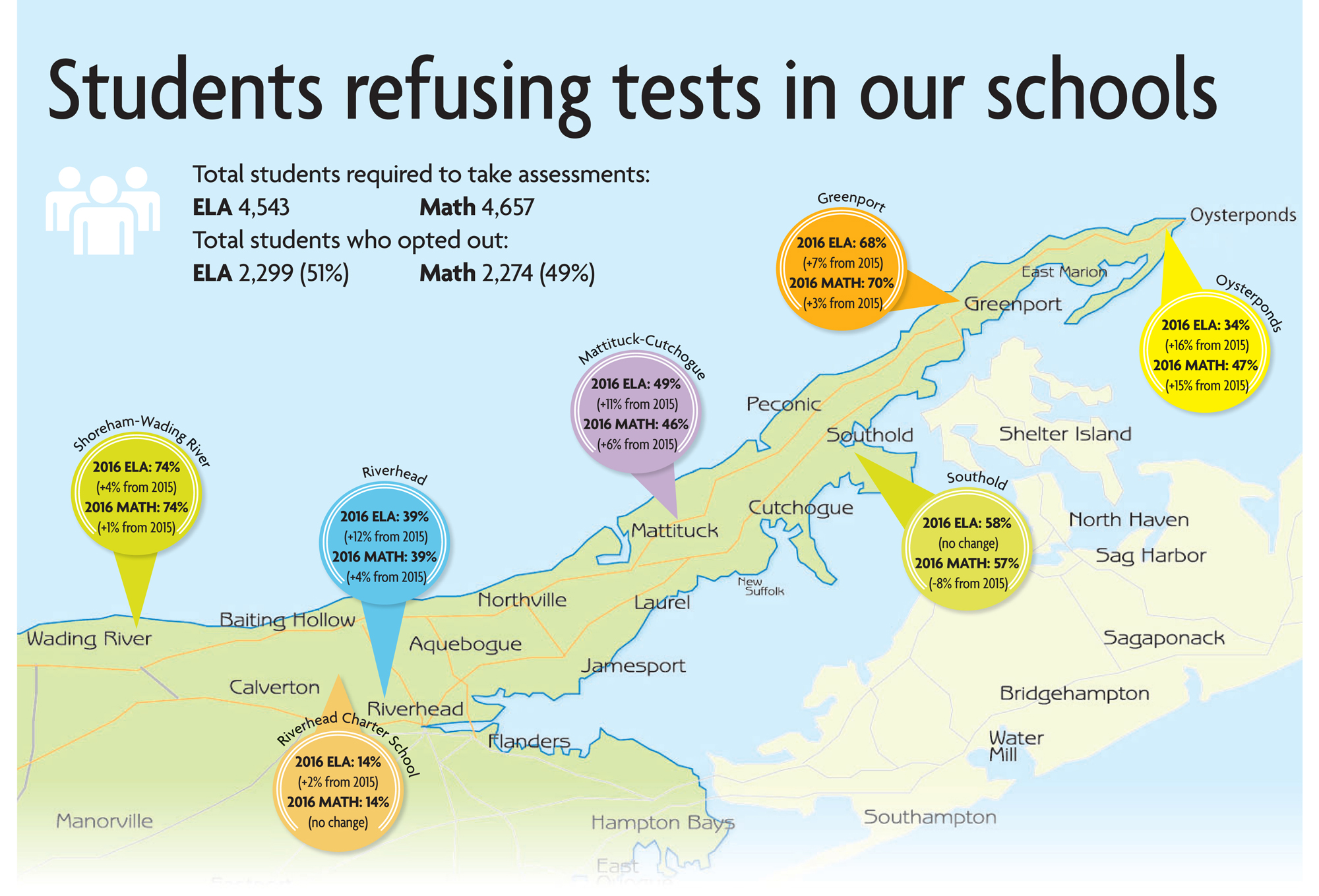Even after compromises, opt-out movement gains steam locally


In response to the large numbers of students who have opted out of state-mandated testing in previous years, New York State education officials recently compromised by agreeing to hold off until 2020 on tying test results to teacher ratings.
This concession, however, has not reduced the opt-out rate among local students.
Across the North Fork, where the tests were administered earlier this month, 51 percent of 4,543 third- through eighth-graders refused to take the English Language Arts exams and 49 percent of 4,657 declined to sit for the math exams. (Some districts don’t count a small percentage of eighth-graders as refusing the tests because they chose to take math Regents exams instead.)
For the past few years, parents and educators have rallied against the state’s latest system of so-called high-stakes testing, which ties teacher evaluations to the controversial Common Core standards. Their principal strategy has been the opt-out movement, under which students refuse to take mandated assessment tests.
[Scroll down to view map]
[Related: Local superintendents’ predictions on the future of state testing]
In the Riverhead Central School District, 805 out of 2,050 students refused this year’s ELA exam and 916 out of 2,341 declined to take the math tests. Compared to last year, these refusals constitute opt-out increases of 12 percent for ELA and 4 percent for math.
Riverhead Superintendent Nancy Carney said the district has seen an influx of non-English-speaking students in recent years.
Since 2009-10, the district’s English Language Learner student population has more than doubled, with more than 1,290 ELL students currently among its overall enrollment of 5,335. The ELL population in 2009-10 was 538 students. And while plenty of native English-speaking children have opted out of the exams, Ms. Carney said she hopes to see a system that is more personalized for all students taking the tests.
“Having a testing system that imposes the same standard against those who are disabled or those who are new to the English language is not helpful to educators who are seeking to help all students succeed,” she said. “As I have stated many times, multiple measures are needed when assessing students.”
In December, the state Board of Regents, which drafts education guidelines for New York public schools, responded to high-stakes testing concerns by imposing a four-year moratorium on using student test scores to evaluate teachers and principals.
Jonathan Burman, spokesman for state Department of Education Commissioner MaryEllen Elia, said there has been an ongoing campaign to reach parents, teachers and students to explain “the improvements we’ve made to the state assessments and the important role they can play in improving instruction.”
“The decision of whether a student should take the state assessments is ultimately for that student’s parent or parents to make,” Mr. Burman said. “But we want to be certain that everyone has all of the information they need to make an informed decision.”

Some who oppose the state’s direction in education say the recent changes aren’t enough. They include Shoreham-Wading School District Superintendent Steven Cohen, who has been an outspoken critic of Common Core.
“The opt-out parents on Long Island and throughout the state are keeping the pressure on,” Mr. Cohen said. “The governor is continuing to ignore the issue of what happens when the moratorium is up. I think those things are political fights that have yet to be resolved.”
In Shoreham-Wading River, 803 out of 1,090 students opted out of this year’s ELA exam and 675 out of 910 refused the math exam. Those numbers reflect increases of 4 percent and 1 percent, respectively, over last year.
Raymond Ankrum, executive director and principal at Riverhead Charter School, described the rollout of the new standards as flawed, since the progression didn’t start with a cohort of kindergartners.
At his school, 31 out of 220 students opted out of both assessments, representing a 2 percent increase for ELA and the same as last year for math.
Currently, federal law requires schools to achieve at least 95 percent student participation in the standardized tests or risk losing federal funding. However, such action has yet to be taken against any school district by the U.S. Department of Education.
Mr. Ankrum said that although he hopes the state will make the necessary adjustments to get “superintendents back on board and advocating for accountability and growth measurement,” he believes the fear of losing federal aid remains a concern among poorer schools districts.
“My prediction is that in affluent areas around the country, the opt-out movement will continue to grow,” he said.
Top photo: (Credit: Flickr/dcJohn)








